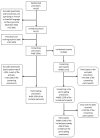Increased Health and Wellbeing in Preschools (DAGIS) Study-Differences in Children's Energy Balance-Related Behaviors (EBRBs) and in Long-Term Stress by Parental Educational Level
- PMID: 30347875
- PMCID: PMC6210204
- DOI: 10.3390/ijerph15102313
Increased Health and Wellbeing in Preschools (DAGIS) Study-Differences in Children's Energy Balance-Related Behaviors (EBRBs) and in Long-Term Stress by Parental Educational Level
Abstract
This paper describes the Increased Health and Wellbeing in Preschools (DAGIS) survey process and socioeconomic status (SES) differences in children's energy balance-related behaviors (EBRBs), meaning physical activity, sedentary and dietary behaviors, and long-term stress that serve as the basis for the intervention development. A cross-sectional survey was conducted during 2015⁻2016 in 66 Finnish preschools in eight municipalities involving 864 children (3⁻6 years old). Parents, preschool personnel, and principals assessed environmental factors at home and preschool with questionnaires. Measurement of children's EBRBs involved three-day food records, food frequency questionnaires (FFQ), seven-day accelerometer data, and seven-day sedentary behavior diaries. Children's long-term stress was measured by hair cortisol concentration. Parental educational level (PEL) served as an indicator of SES. Children with low PEL had more screen time, more frequent consumption of sugary beverages and lower consumption of vegetables, fruit, and berries (VFB) than those with high PEL. Children with middle PEL had a higher risk of consuming sugary everyday foods than children with high PEL. No PEL differences were found in children's physical activity, sedentary time, or long-term stress. The DAGIS intervention, aiming to diminish SES differences in preschool children's EBRBs, needs to have a special focus on screen time and consumption of sugary foods and beverages, and VFB.
Keywords: children; cortisol; energy balance-related behaviors; fruit and vegetables; long-term stress; needs assessment; preschool; screen time; socioeconomic differences; sugary foods and beverages.
Conflict of interest statement
Liisa Korkalo is a board member of TwoDads Ltd. Other authors declare that they have no competing interests. The funders had no role in the design of the study; in the collection, analyses, or interpretation of data; in the writing of the manuscript, or in the decision to publish the results.
Figures
Similar articles
-
Effects of the Preschool-Based Family-Involving DAGIS Intervention Program on Children's Energy Balance-Related Behaviors and Self-Regulation Skills: A Clustered Randomized Controlled Trial.Nutrients. 2020 Aug 26;12(9):2599. doi: 10.3390/nu12092599. Nutrients. 2020. PMID: 32859118 Free PMC article. Clinical Trial.
-
Increased health and well-being in preschools (DAGIS): rationale and design for a randomized controlled trial.BMC Public Health. 2015 Apr 18;15:402. doi: 10.1186/s12889-015-1744-z. BMC Public Health. 2015. PMID: 25927298 Free PMC article. Clinical Trial.
-
Are associations between home environment and preschool children's sedentary time influenced by parental educational level in a cross-sectional survey?Int J Equity Health. 2021 Jan 9;20(1):27. doi: 10.1186/s12939-020-01333-x. Int J Equity Health. 2021. PMID: 33422074 Free PMC article.
-
The Role of Energy Balance-Related Behaviors (EBRBs) and their Determinants on the Prevalence of Overweight and Obesity in Children in Need, in Greece: A Scoping Review.Curr Nutr Rep. 2024 Nov 9;14(1):2. doi: 10.1007/s13668-024-00593-1. Curr Nutr Rep. 2024. PMID: 39516392
-
[Simple obesity in children. A study on the role of nutritional factors].Med Wieku Rozwoj. 2006 Jan-Mar;10(1):3-191. Med Wieku Rozwoj. 2006. PMID: 16733288 Review. Polish.
Cited by
-
Effects of the Preschool-Based Family-Involving DAGIS Intervention Program on Children's Energy Balance-Related Behaviors and Self-Regulation Skills: A Clustered Randomized Controlled Trial.Nutrients. 2020 Aug 26;12(9):2599. doi: 10.3390/nu12092599. Nutrients. 2020. PMID: 32859118 Free PMC article. Clinical Trial.
-
Investigating preschool-aged chronotype and social jetlag as predictors of early adolescent diet and BMI z-score: an eight-year follow-up from the DAGIS study.Int J Obes (Lond). 2025 May;49(5):793-800. doi: 10.1038/s41366-024-01702-4. Epub 2024 Dec 19. Int J Obes (Lond). 2025. PMID: 39702528 Free PMC article.
-
Cross-sectional relation of long-term glucocorticoids in hair with anthropometric measurements and their possible determinants: A systematic review and meta-analysis.Obes Rev. 2022 Mar;23(3):e13376. doi: 10.1111/obr.13376. Epub 2021 Nov 22. Obes Rev. 2022. PMID: 34811866 Free PMC article.
-
Compliance with the 24-h movement guidelines and the relationship with anthropometry in Finnish preschoolers: the DAGIS study.BMC Public Health. 2019 Dec 3;19(1):1618. doi: 10.1186/s12889-019-7967-7. BMC Public Health. 2019. PMID: 31796014 Free PMC article.
-
Parents' Reports of Preschoolers' Diets: Relative Validity of a Food Frequency Questionnaire and Dietary Patterns.Nutrients. 2019 Jan 13;11(1):159. doi: 10.3390/nu11010159. Nutrients. 2019. PMID: 30642103 Free PMC article.
References
-
- Veijalainen A., Tompuri T., Haapala E.A., Viitasalo A., Lintu N., Väistö J., Laitinen T., Lindi V., Lakka T.A. Associations of cardiorespiratory fitness, physical activity, and adiposity with arterial stiffness in children. Scand. J. Med. Sci. Sports. 2016;26:943–950. doi: 10.1111/sms.12523. - DOI - PubMed
-
- Erkkola M., Kronberg-Kippilä C., Kyttälä P., Lehtisalo J., Reinivuo H., Tapanainen H., Veijola R., Knip M., Ovaskainen M.-L., Virtanen S.M. Sucrose in the diet of 3-year-old Finnish children: Sources, determinants and impact on food and nutrient intake. Br. J. Nutr. 2009;101:1209–1217. doi: 10.1017/S0007114508057619. - DOI - PubMed
-
- Lampinen E.K., Eloranta A.M., Haapala E.A., Lindi V., Väistö J., Lintu N., Karjalainen P., Kukkonen-Harjula K., Laaksonen D., Lakka T.A. Physical activity, sedentary behaviour, and socioeconomic status among Finnish girls and boys aged 6–8 years. Eur. J. Sport Sci. 2017;17:462–472. doi: 10.1080/17461391.2017.1294619. - DOI - PubMed
Publication types
MeSH terms
LinkOut - more resources
Full Text Sources
Medical


